Dealing with Fading Light
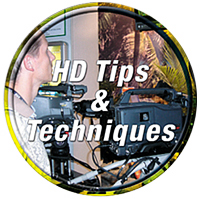
LOS ANGELES
Recently while working with the Canon EOS 7D for a review, I was looking for a practical test to put the camera through and I tapped my friend, director Jamie Neese, to come up with a short project we could shoot in a day. He came back with a 5-page script called "Breaking Up is Hard to Do" and enlisted the help of actors Mark Gerson ("Two Million Stupid Women") and Lisa Jay ("Days of Our Lives"). After reading the script, I decided to go with a look that felt like late afternoon warm sunlight. I planned to augment natural daylight with soft, 3/4 back keys and nice hot, warm sunlight feel. I had a very small lighting package available to me, an Arri Fresnel kit with a 650 Watt, 300 Watt and two 150 Watt fixtures.
The scene was all interior in an apartment living room. Anna (Lisa Jay) is visited by Derek (Mark Gerson) who has been employed by her boyfriend to break up with her. I had a roll of full CTO gel and planned on covering the windows to convert the natural daylight to 3200K so I could use my tungsten fixtures at their natural color temperature. The idea was to make the most of natural daylight and augment where I had to with the small fixtures.

Fig. 1: Mark at the doorFADING LIGHT
Unfortunately, the rains came to Los Angeles that Sunday afternoon. The day was very gloomy, cloudy and sunless. Ambient color temperature was in the high 9000K range. We also got off to a late start, not rolling until after 3:00 p.m. with the January light fading quickly. Therein was my challenge. Could I get the look I wanted with a small kit, all tungsten units, and fading daylight?
The answer was "yes."
I was working with some slow EF lenses, an 18-55 and a 28-135, both in the F4.5–5 range. Luckily, the sensitivity of the EOS 7D was certainly in my corner as I was able to shoot a clean image at an ISO of 2500.
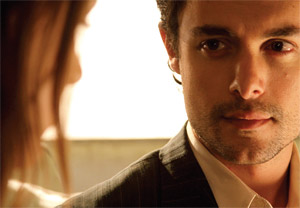
Fig. 2: Mark on couch The key here was to get the wide shots as early in the day as we could—while we still had natural daylight to help—and carefully compose the tighter shots to make the best use of the kit I had.
We started at the apartment door when Anna opens the door to Derek (Fig. 1). The lobby of the location features a French-paned front door that I knew I couldn't fake daylight, so that dictated where we started.
I first covered the door with a sheet of full CTO to help reduce the color temperature of the natural daylight. I then created a "book light" in the corner outside the apartment door by bouncing a 300 Watt into the corner and then taping 250 diffusion behind the fixture so that the light would bounce off the walls and then pass through the diffusion. This technique allowed me to create a large soft source in a very tight space. The light from the "book light" created a key on Mark from his left side. On his right side, I used a 150 Watt bounced into an 18" x 24" piece of white foamcore. Inside the apartment, I kept it low, with just a 150 Watt bounced into the ceiling behind Lisa to help bring up her shoulder and back of her head from the shadows.
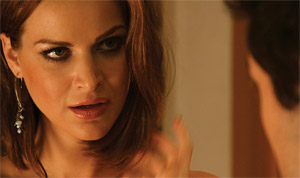
Fig. 3: Lisa on couch As the scene progresses, Derek sits Anna down and explains to her that he has been hired by her boyfriend to "dissolve" the relationship (Fig. 2). By the time we got to this coverage, night had fallen. The front wall of the location has three windows, but I explained to director Neese that I only had enough fixtures to light one window and the inside. We adjusted the composition so that the actor was squarely in front of one of the windows and the other two were out of the shot.
I covered the outside of the window with an opaque white shower curtain and lit it with the 650 Watt from about 4 feet away, covering primarily the lower 1/3 of the window that would be seen in the shot. This created a hot, bright white, world outside the window that passed for natural daylight.
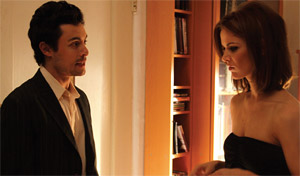
Fig. 4: Two-shot at door To continue this feel, I used a 150 Watt high and behind Mark to get hot light on his shoulders, as if coming through the window. I used the second 150 Watt off his right shoulder with some 250 diffusion to continue that "window" light around the right side of his face and create a hot 3/4 back edge. Finally, I used the 300 Watt into a 3' x 3' piece of white foamcore that was positioned low, about his knee height, to create the soft key bounce as if it were coming from hot natural daylight bouncing off the floor onto his face. I snuck in a Litepanels Micro on top of the 7D to get a little glimmer in Mark's eyes.
The same technique, roughly, applies to Lisa's coverage in this scene, (Fig. 3), except that she's sitting opposite the window so I eliminated the hot edges. She's lit from the 300 Watt bouncing into the 3x3 foamcore as her key, again low, and the 150 Watt with the 250 diffusion high and off her left shoulder for fill.
OPENING THE BARN DOORS
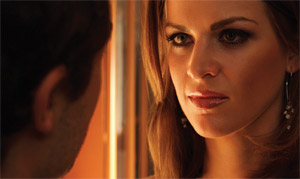
Fig. 5: Lisa close at the door The confrontation comes to a head and she leads him to the door where he pleads with her to succumb to reason (Fig. 4). For the two-shot here, I stretched out the white shower curtain on the floor and bounced the 650 Watt into it from behind Lisa. I "double-dutied" the 650 by opening the barn doors and making sure the edge of the direct light also hit the bookshelves and door to mimic the feel of natural daylight through a window behind them. The hotspot of the light is focused onto the shower curtain and lower part of the door to reflect back on them as a low side key. The camera-side is filled with the 300 Watt into the ceiling to provide a base level "room tone."
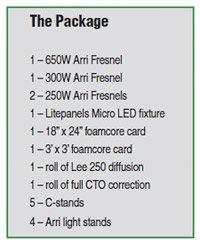
This same technique tracks into the close here (Fig. 5), with Lisa's main key coming from the floor and lower portion of the white door to her right. Her left side is filled from the 300 Watt bounced off the white ceiling and, again, I pulled out the Litepanels Micro on top of the camera to get the sparkle in her eye.
Lighting with a small kit is definitely a challenge, but entirely doable if you're careful about how you use it. The additional trick to this particular look is to try and keep the keys as more backlights and, when possible, on the off-camera side. I rarely use low positioned sources as key sources, but sometimes it can create really beautiful light.
Jay Holben is a director, producer and cinematographer living in Los Angeles. He is also the Technical Editor of DV Magazine.
The professional video industry's #1 source for news, trends and product and tech information. Sign up below.
